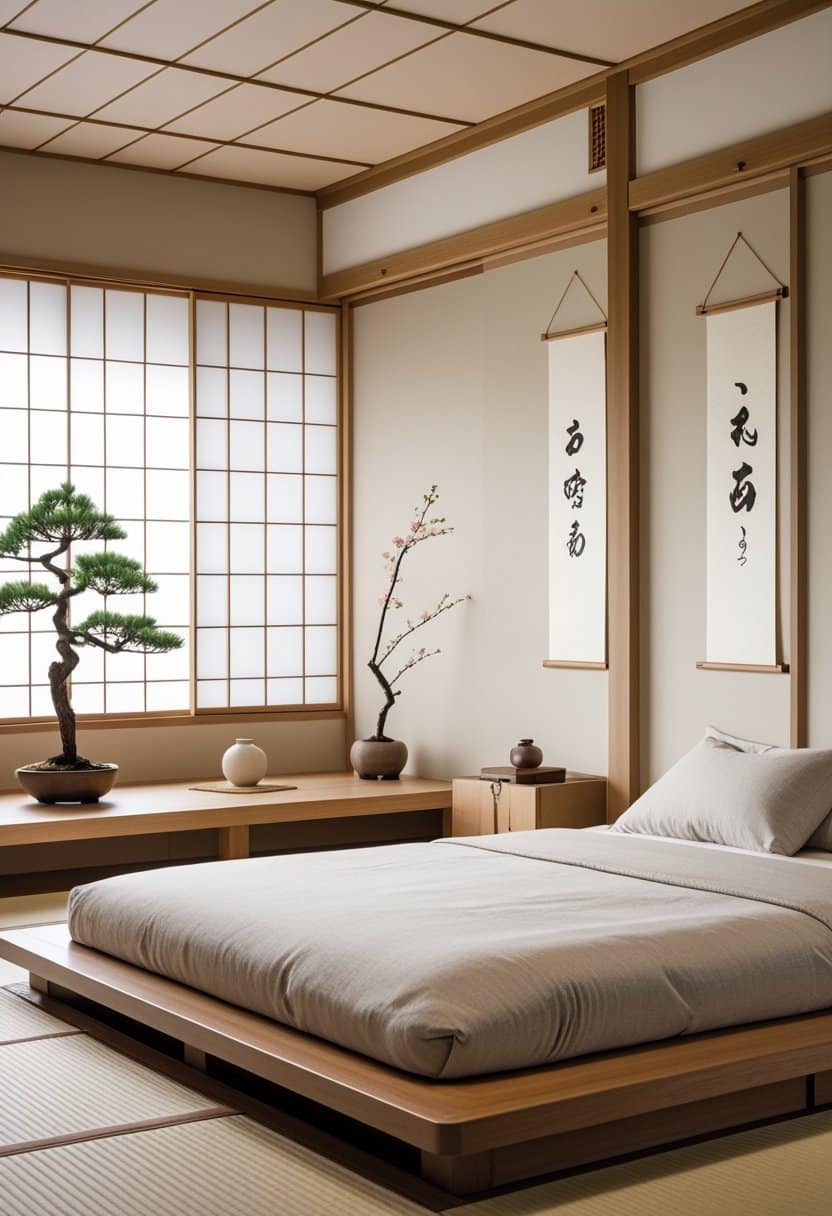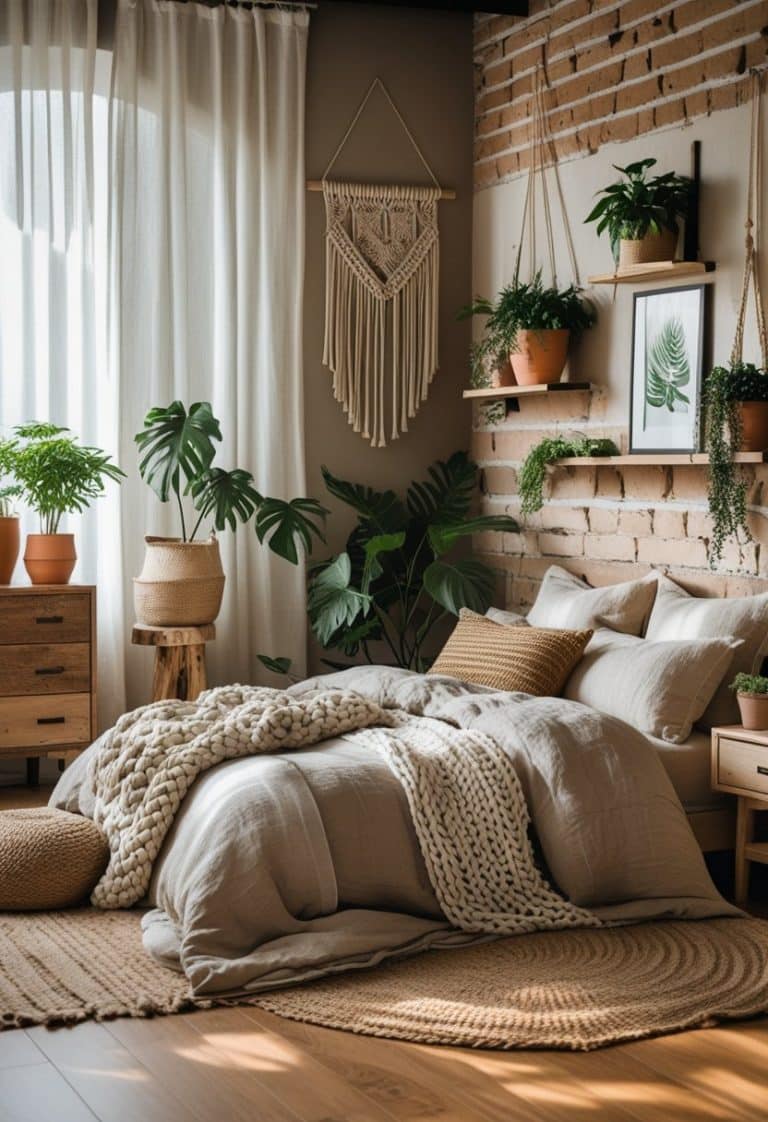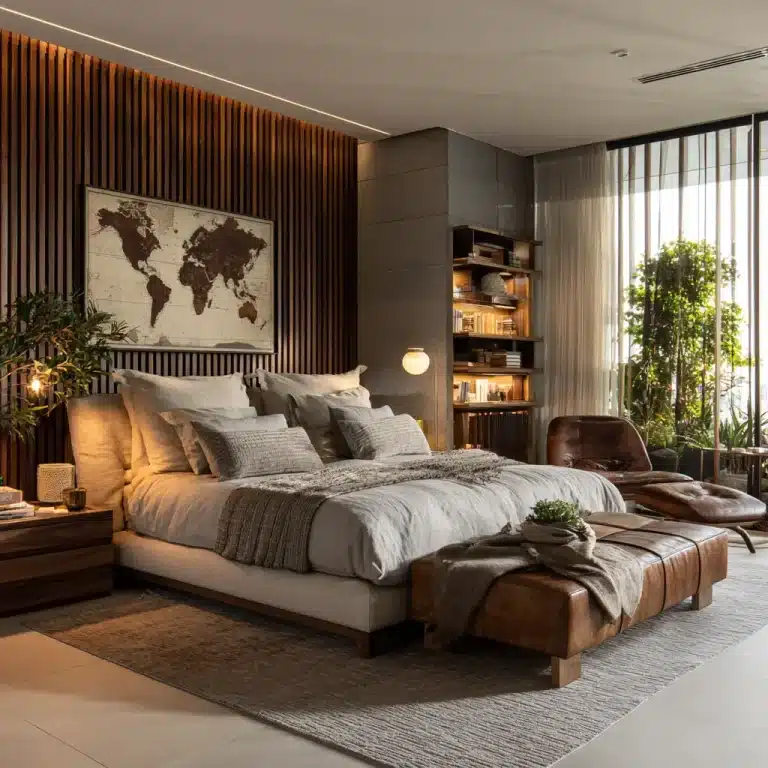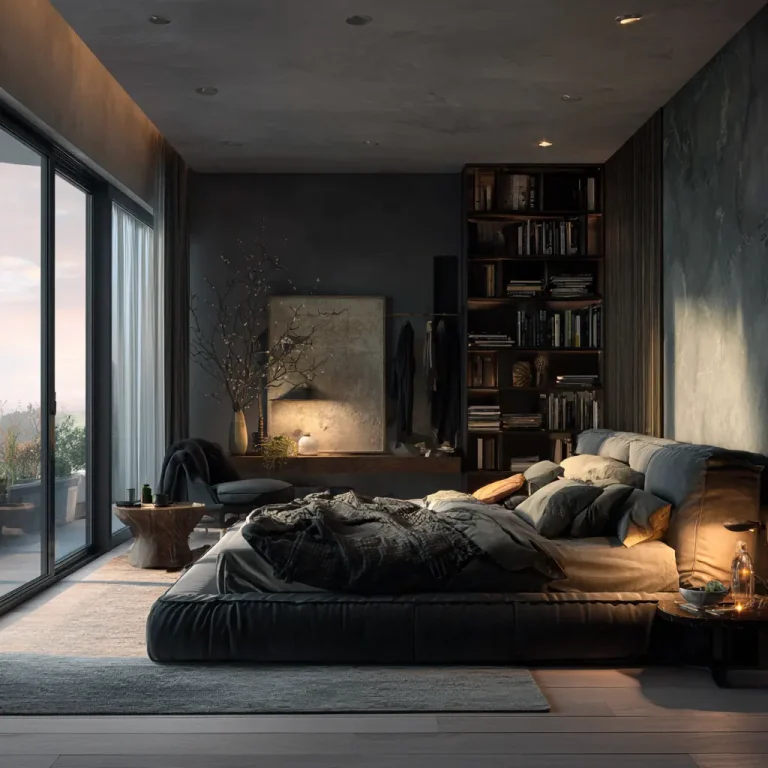Japanese Bedroom Design: 21 Ideas for a Calm and Minimal Space

Japanese bedroom design offers a calm and balanced approach to creating a personal space. It focuses on simplicity, natural elements, and a sense of order that encourages relaxation. It shows how small details in layout, furniture, and materials can shape a peaceful environment that feels both timeless and practical.

This design style connects traditional Japanese aesthetics with modern living. By exploring its core principles and the elements that define it, anyone can see how these spaces achieve harmony without excess. The following sections highlight how these ideas come together to form a bedroom that feels restful and intentional.
Tatami Mats for Flooring

Tatami mats give a Japanese bedroom its distinct look and feel. Made from rush grass and a straw or foam base, they provide a natural surface underfoot.
They help create a calm and simple space. Many people use them for sleeping, sitting, or practicing meditation.
Shoji Sliding Doors

Shoji sliding doors use wooden frames with translucent paper or glass panels. They allow natural light to pass through while still offering privacy.
In bedrooms, they save space compared to hinged doors. Their simple design blends well with both traditional and modern interiors.
Many homeowners use them as doors, closets, or room dividers.
Futon Mattress on Floor

A futon mattress placed directly on the floor reflects traditional Japanese bedroom design. It creates a simple and uncluttered look.
These mattresses are lightweight and easy to fold, making storage practical. They allow the room to serve multiple purposes throughout the day.
Many people use futons with tatami mats for added comfort and support.
Low Wooden Platform Bed

A low wooden platform bed reflects the simplicity of Japanese bedroom design. It sits close to the floor, creating a grounded and open look.
These beds often use solid wood and clean lines. The low height pairs well with futons or modern mattresses.
The design emphasizes stability and function while keeping a calm, uncluttered style.
Natural Bamboo Blinds

Natural bamboo blinds bring texture and warmth to a Japanese bedroom. They filter light softly, creating a calm and balanced atmosphere.
Made from sustainable materials, bamboo blinds support eco-friendly design choices. Their simple look pairs well with minimalist interiors and traditional Japanese elements.
Washi Paper Lanterns

Washi paper lanterns bring soft, diffused light that suits a calm bedroom setting. Their shades, often crafted from mulberry-based paper, create a warm glow without harsh brightness.
Many designs follow traditional Japanese methods, including Gifu lantern-making. These lamps combine simple forms with natural materials, fitting well in minimalist or Japandi interiors.
Minimalist Wooden Dressers

Minimalist wooden dressers fit well in Japanese bedrooms because they balance function and simplicity.
They use clean lines and natural wood tones that create a calm look.
These pieces provide storage without making the room feel crowded or distracting.
Zen Rock Garden Decor

A Zen rock garden adds a calm and natural element to a Japanese bedroom. It often includes smooth stones, sand, or gravel arranged in simple patterns.
People may place a small tray garden on a low table or shelf. This creates a quiet focal point without taking up much space.
The design stays minimal, which matches the clean lines and open feel of Japanese interiors.
Ikebana Floral Arrangements

Ikebana brings a sense of balance and calm into the bedroom through simple floral displays.
This Japanese art form focuses on line, space, and natural harmony rather than large bouquets.
By using seasonal branches and flowers, it creates a subtle connection to nature within the room.
Neutral Color Palette

Japanese bedroom design often uses calm, muted colors to create a sense of balance.
Shades like beige, soft gray, off-white, and muted greens reflect natural elements.
These tones help the room feel simple, uncluttered, and restful without drawing too much attention.
Sliding Fusuma Panels

Fusuma are opaque sliding panels used in Japanese bedrooms to divide spaces or serve as doors. They move smoothly on wooden tracks and can be removed when needed.
These panels often match the size of tatami mats and help create flexible room layouts. Their paper or fabric coverings add simple decorative detail.
Simple Linen Bedding

Linen bedding supports the minimalist approach found in Japanese bedroom design. Its natural texture and muted colors create a calm and uncluttered look.
The fabric allows airflow, which helps maintain comfort through different seasons. Many choose linen for its balance of simplicity, function, and quiet style.
Tokonoma Alcove Display

A tokonoma is a recessed alcove traditionally found in Japanese rooms. It serves as a place to display items such as hanging scrolls, calligraphy, or flower arrangements.
The alcove is usually positioned opposite the entrance, creating a focal point in the room. Its design emphasizes simplicity and careful placement.
Even in modern homes, people may adapt the concept with shelves or minimalist displays. This maintains the spirit of showcasing art and seasonal beauty.
Bonsai Tree Accent

A bonsai tree adds a natural focal point to a Japanese bedroom. Its compact size makes it easy to place on a nightstand, dresser, or low table.
The tree’s shape and greenery bring balance to the room’s simple design. It supports a calm and uncluttered atmosphere.
Rice Straw Tatami Edging

Tatami mats use rice straw cores with fabric or woven edging to protect the seams. This edging helps prevent fraying and adds a finished look to the mat.
The edging also guides how mats are placed in a room, since traditional layouts avoid aligning seams in straight continuous lines.
Recessed Wall Shelves

Recessed wall shelves provide storage without taking up floor space. They fit neatly into the wall, keeping the room open and uncluttered.
In Japanese bedroom design, these shelves often display simple decor like ceramics, books, or plants. Their clean lines match the minimalist style.
They also create subtle depth in the wall, adding function while maintaining a calm atmosphere.
Soft Ambient Lighting

Soft ambient lighting sets a calm tone in a Japanese bedroom. It reduces harsh brightness and creates a balanced atmosphere.
Paper lanterns and lamps with rice paper shades diffuse light gently. Their glow helps the room feel warm without being overwhelming.
Adjustable dimmable lights give flexibility. They allow the space to shift from functional brightness to a softer, restful mood.
Natural Wood Ceiling Beams

Natural wood ceiling beams add warmth and texture to a Japanese-inspired bedroom. They highlight the connection to nature, which is central to traditional design.
Exposed beams also create a sense of structure and balance. When paired with light ceiling panels, they provide contrast without overwhelming the space.
Japanese Calligraphy Art

Japanese calligraphy, or shodo, brings cultural depth and visual balance to a bedroom.
Many people choose a single word or phrase to display, keeping the design simple and meaningful.
Placed on walls or screens, calligraphy art adds a traditional element without overwhelming the minimalist style.
Woven Straw Floor Cushions

Woven straw floor cushions add a natural element to Japanese bedroom design. They are often handmade using straw or rattan, giving them a simple, textured look.
These cushions work well for seating, meditation, or tea ceremonies. Their lightweight design makes them easy to move and use in different spaces.
Wooden Tansu Storage Chest

A wooden tansu storage chest is a traditional Japanese piece used for organizing clothes and household items.
Crafted mainly from woods like kiri or keyaki, it often includes drawers, sliding doors, and iron hardware.
Its compact and portable design made it practical in Japanese homes with limited fixed furniture.
Core Principles of Japanese Bedroom Design

Japanese bedroom design focuses on creating a calm environment through simplicity, natural elements, and careful spatial planning. Each detail serves a purpose, from the choice of materials to the way furniture is arranged.
Minimalism and Functionality
Minimalism guides Japanese interiors by removing unnecessary items and keeping only what is useful. A bedroom often contains only essential furniture such as a futon, a low bed frame, or a small storage unit. This approach keeps the space open and uncluttered.
Functionality is equally important. Items are chosen for their practicality and often serve multiple purposes. For example, futons can be folded and stored during the day, allowing the room to be used for other activities.
Storage solutions remain discreet. Built-in closets, sliding doors, and hidden compartments help maintain clean lines. By combining minimalism with functionality, the bedroom becomes efficient without losing comfort.
Natural Materials and Textures
Japanese bedrooms rely on natural materials that create a warm and calming atmosphere. Wood is widely used for flooring, furniture, and sliding doors. Bamboo, paper, and cotton add texture without overwhelming the space.
Tatami mats are a common feature, offering both comfort and a connection to tradition. Their natural scent and woven surface bring subtle character to the room.
Soft textiles like linen or cotton bedding enhance comfort while keeping the design simple. The focus on natural materials also supports durability and sustainability, which are valued in Japanese design.
Balance and Harmony
Balance in Japanese bedrooms comes from proportion, symmetry, and careful arrangement of elements. Furniture is kept low to the ground, which creates a sense of stability and calm.
Harmony is achieved through neutral colors and natural light. Shades of beige, brown, and muted green are common, often paired with shoji screens that filter sunlight softly into the room.
The concept of ma, or the use of empty space, plays a central role. Open areas are left untouched to allow the room to breathe. This balance between filled and empty space ensures the bedroom feels peaceful and uncluttered.
Integrating Japanese Aesthetics in Modern Spaces

Japanese bedroom design often combines natural materials, clean lines, and calming colors with modern functionality. This approach creates spaces that feel balanced, practical, and visually simple without losing warmth or character.
Blending Traditional and Contemporary Elements
A modern Japanese bedroom often uses tatami mats, shoji screens, or low wooden platforms as a base. These traditional features ground the room in cultural roots while still allowing flexibility for modern furniture.
To keep the space functional, many designs add built-in storage, sliding doors, or modular shelving. This reduces clutter while preserving the open and minimal feel that defines Japanese interiors.
Color choices usually lean toward neutral palettes like beige, soft gray, and natural wood tones. These colors highlight the textures of bamboo, linen, and light wood. In contrast, modern accents such as a sleek lamp or metal frame can add subtle variety without overwhelming the space.
The key balance lies in layering tradition with updates. For example, a futon mattress can rest on a raised wooden platform instead of the floor, offering comfort while maintaining the low-profile look.
Lighting Techniques for Tranquility
Lighting plays a central role in shaping a calm Japanese-inspired bedroom. Soft, indirect light works best, avoiding harsh overhead fixtures. Many designs use paper lanterns, wall sconces, or floor lamps with diffused shades to create a warm glow.
Natural light also matters. Large windows or sliding glass doors framed with wood allow sunlight to filter in during the day. Sheer curtains or shoji screens help soften brightness while maintaining privacy.
For evening, layered lighting ensures flexibility. A combination of dimmable ceiling lights and smaller accent lamps lets the room shift from functional brightness to a restful atmosphere.
Warm white bulbs are preferred over cool tones, as they reflect the natural warmth of wood and textiles. This careful use of light supports both relaxation and visual harmony.






